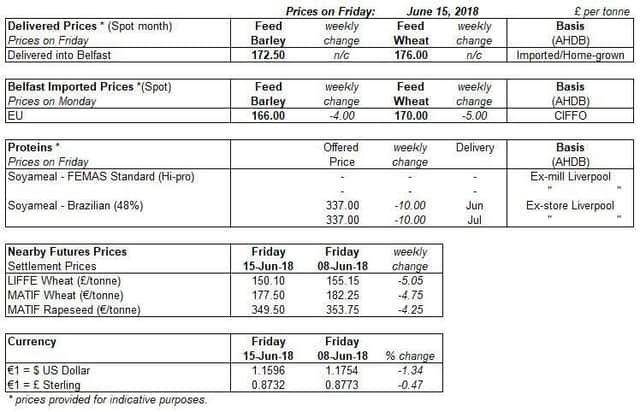MI Northern Ireland Market Report


Global grains markets softened over the week (8 June - 15 June), despite a brief surge in wheat driven by the USDA’s world supply and demand estimates report.
It lent a bullish tone to the beginning of the week which saw new crop wheat futures soar in the US and Europe. Since then, the ongoing US/China trade dispute has weighed on the market, as well as favourable conditions for maize in the US and wheat in southern Europe.
Advertisement
Advertisement
Dryness in Russia following wet spring weather has lead the USDA to revise its estimates of 2018/19 Russian wheat production down by 3.5Mt to 68.5Mt. This projection represents a 19% decline in Russian wheat production from 2017/18 which could have implications for Russia’s exportable surplus this year.
On the back of insufficient rainfall in Ukraine, UkrAgroConsult has lowered its production forecasts for wheat and barley in 2018/19. Wheat production is forecast to be at 25.5Mt, down from 26.3Mt in May and the lowest since 2014/15. As a result, the consultancy also reduced its forecast of the country’s export potential to 16Mt, down 6% year on year.
Dry weather in Baltic Sea countries is threatening northern Europe’s wheat production with Reuters reporting excessive dryness in Denmark, Sweden, northern Germany, Poland and Lithuania.
On Friday, the US/China trade dispute escalated as the US confirmed the products that would be subject to tariffs. This was swiftly followed by a similar announcement by China. US soyabeans will be subject to a 25% import tariff from 6 July. Nearby US soyabean futures fell to a two year low by the end of trading on 19 June as the US threatened to impose a further raft of tariffs.
Advertisement
Advertisement
Last Tuesday the USDA reduced its forecast of global rapeseed output in 2018/19 by 0.35Mt to 75.1Mt on the back of a cut to EU production (74.3Mt in 2017/18).While rapeseed conditions in parts of Canada are looking better than last year, there was further unfavourable news later in the week for the French and Australian crops. As such, the oilseed may have some power to resist the downward pressure from soyabean prices.